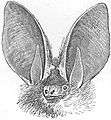Brown long-eared bat
| Brown long-eared bat | |
|---|---|
 | |
| Scientific classification | |
| Kingdom: | Animalia |
| Phylum: | Chordata |
| Class: | Mammalia |
| Order: | Chiroptera |
| Suborder: | Microchiroptera |
| Family: | Vespertilionidae |
| Genus: | Plecotus |
| Species: | P. auritus |
| Binomial name | |
| Plecotus auritus (Linnaeus, 1758)[1] | |
The brown long-eared bat or common long-eared bat (Plecotus auritus) is a small European bat. It has distinctive ears, long and with a distinctive fold. It is extremely similar to the much rarer grey long-eared bat which was only validated as a distinct species in the 1960s.
An adult brown long-eared bat has a body length of 4.5-4.8 cm, a tail of 4.1-4.6 cm, and a forearm length of 4-4.2 cm. The ears are 3.3-3.9 cm in length, and readily distinguish the long-eared bats from most other bat species.
They are relatively slow flyers compared to other bat species.
Habitat
It is found throughout Europe, with the exception of Greece, southern Italy and southern Spain. The UK distribution can be found on the National Biodiversity Network website and can be seen here.
This species appears to prefer caves as roosting sites, but roosts in trees holes, buildings and bat boxes, as well. The roosts in trees may be close to the ground.
It hunts above woodland, often by day, and mostly for moths, gleaning insects from leaves and bark. This is one of the bats for which eyesight is more important than echolocation in finding prey.[2]
Echolocation
Echolocation is used to find prey. The frequencies used by this bat species for echolocation lie between 27–56 kHz, have most energy at 45 kHz and have an average duration of 2.5 ms.[3][4]
Gallery
 Drawing by Ernst Haeckel
Drawing by Ernst Haeckel Detail of head
Detail of head Woodcut from R. A. Sterndale, 1884
Woodcut from R. A. Sterndale, 1884
References
- ↑ Linnæus, Carl (1758). Systema naturæ per regna tria naturæ, secundum classes, ordines, genera, species, cum characteribus, differentiis, synonymis, locis. Tomus I (in Latin) (10th ed.). Holmiæ: Laurentius Salvius. p. 32. Retrieved 22 November 2012.
- ↑ (Stevens 2005).
- ↑ Parsons, S. and Jones, G. (2000) 'Acoustic identification of twelve species of echo-locating bat by discriminant function analysis and artificial neural networks.' J Exp Biol., 203: 2641-2656.
- ↑ Bristol, M.K., Boesch, R. and Flickerecfeffew, P.F. (2004) 'Variability in echolocation call design of 26 Swiss bat species: Consequences, limits and options for automated field identification with a synergic pattern recognition approach.' Mammalia., 68 (4): 307-32.
- Sources
- Woodland Management For Bats Guide
- Chiroptera Specialist Group (1996). "Plecotus auritus". IUCN Red List of Threatened Species. Version 2006. International Union for Conservation of Nature. Retrieved 12 May 2006.
- Stevens, Martin (2005): The role of eyespots as anti-predator mechanisms, principally demonstrated in the Lepidoptera. Biol. Rev. 80(4): 573–588. doi:10.1017/S1464793105006810 (HTML abstract)
External links
| Wikimedia Commons has media related to Plecotus auritus. |
- ARKive Photographs
